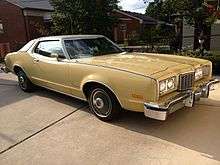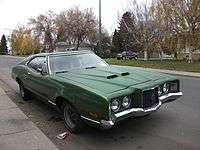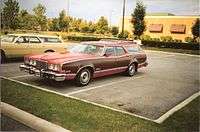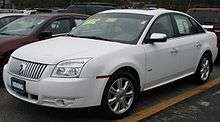Mercury Montego
| Mercury Montego | |
|---|---|
 | |
| Overview | |
| Manufacturer | Mercury (Ford) |
| Production |
1968–1976 2005–2007 |
| Assembly |
Atlanta, Georgia, United States Milpitas, California, United States Lorain, Ohio, United States Chicago, Illinois, United States Oakville, Ontario, Canada |
The Mercury Montego is a nameplate that was applied to three distinct vehicles marketed by Mercury. The nameplate first appeared in 1967 in Canada as part of the Mercury-derived Meteor line. In 1968, it was introduced in the United States as part of the intermediate lineup, becoming the Mercury equivalent of the two generations of the Ford Torino for its entire production run. For the 1977 model year, all intermediate Mercurys adopted the Cougar nameplate and the Montego line was dropped.
From the 2005 to 2007, the Montego name was revived for a full-size car, a rebadged variant of the Ford Five Hundred, slotting in between the Mercury Milan and the Mercury Grand Marquis. For 2008, the Montego adopted the nameplate of the car it was intended to replace, becoming the Mercury Sable.
The Montego name is derived from Montego Bay, Jamaica. The name was also used on a car from Austin/Rover from 1984 to 1995.
First generation (1968–1971)
| 1968–1971 | |
|---|---|
|
1969 Mercury Montego 2-door hardtop | |
| Overview | |
| Production | 1968–1971 |
| Body and chassis | |
| Class | Intermediate |
| Body style |
4-door sedan 4-door wagon 2-door hardtop coupe 2-door convertible |
| Layout | FR layout |
| Related | Ford Torino |
| Powertrain | |
| Engine |
250 cu in (4.1 L) I6 302 cu in (4.9 L) V8 351 cu in (5.8 L) V8 390 cu in (6.4 L) V8 400 cu in (6.6 L) V8 429 cu in (7.0 L) V8 |
| Transmission |
3-speed automatic 3-speed manual 4-speed manual |
| Dimensions | |
| Wheelbase |
116.0 in (2,946 mm) 113.0 in (2,870 mm) (wagon)[1] 117.0 in (2,972 mm) (1970-71) 114.0 in (2,896 mm) (70-71 wagon) |
| Length |
206.0 in (5,232 mm) 204.0 in (5,182 mm) (wagon) |
| Chronology | |
| Predecessor | Mercury Comet |
| Successor |
Mercury Cougar (coupe) Mercury Monarch (sedan & wagon) |
The Montego was introduced for 1968 as an upscale version of the intermediate Mercury Comet, which it eventually supplanted after 1969. It was essentially a twin of the Ford Torino. The Cyclone was a high performance variant of the Montego through 1971.
The 1968 models were available in four body styles: four-door sedan, two-door hardtop, station wagon and convertible, in base and fancier MX trim.
For 1970, the convertible was dropped, but new four-door hardtops and woodgrained MX Villager station wagon were added to the model selection. The 1970 and 1971 Montegos (and Cyclones) were notable for their striking forward-thrusting hood and grille centers. Concealed headlamps provided extra distinction for 1970 Broughams and Villagers.


Second generation (1972-1976)
| 1972–1976 | |
|---|---|
 1974 Mercury Montego MX Brougham | |
 | |
| Overview | |
| Production | 1972–1976 |
| Body and chassis | |
| Class | Intermediate |
| Body style |
4-door sedan 4-door station wagon 2-door hardtop coupe 2-door fastback coupe |
| Layout | FR layout |
| Related |
Ford Torino Mercury Cougar |
| Powertrain | |
| Engine |
250 cu in (4.1 L) I6 302 cu in (4.9 L) V8 351 cu in (5.8 L) V8 390 cu in (6.4 L) V8 400 cu in (6.6 L) V8 460 cu in (7.5 L) V8[1][2] |
| Transmission |
3-speed automatic 3-speed manual |
| Dimensions | |
| Wheelbase |
118.0 in (2,997 mm) (sedan, wagon) 114.0 in (2,896 mm) (coupe, convert.)[2] |
| Length |
223.1 in (5,667 mm) (sedan, wagon) 215.5 in (5,474 mm) (coupe, convert.) |
| Chronology | |
| Predecessor |
Mercury Comet Mercury Cyclone |
| Successor |
Mercury Cougar (sedan & wagon) Mercury Monarch (coupe) |
The 1972 Montego (and Torino, which the Montego very closely resembled)[3] was fully restyled. Whereas previous Montegos (except wagons) had been produced on a single wheelbase with unitized construction, the 1972-1976 models were built body-on-frame and used a 114-inch (2,900 mm) span for coupe models, 118 inches for sedans and wagons. Although Ford called the four-door sedans "pillared hardtops", they used a thin "B" pillar with frameless door glass, and true four-door hardtops were not offered in this generation. In 1972 and 1973, a sporty fastback coupe called Montego GT (mirroring Ford's Gran Torino SportsRoof) was offered, replacing the Cyclone. 1972 sales were up 136% over the previous year,[4] with the MX Brougham showing enormous increases, almost 897% in the 2-door and nearly 1,021% in the 4-door.[4]
Montego sales through 1973 remained good, but were subsequently depressed by gas mileage concerns, and in-house competition from a restyled 1974 Cougar cast in the personal luxury mold and built on the Montego's platform with similar styling, and the more efficient Monarch introduced for 1975. For 1977, the Montego name was dropped, with Mercury's restyled intermediates all taking the Cougar name.
Six-cylinder engines were offered in Montegos through 1973. V8 power—up to a massive 460 cubic inches from 1974 forward—was available throughout the entire run.


Third generation (2005–2007)
| 2005–2007 (D333) | |
|---|---|
 2005 Mercury Montego Premier | |
| Overview | |
| Also called | Ford Five Hundred |
| Production | July 2004–April 2007 |
| Assembly | Chicago, Illinois, United States |
| Body and chassis | |
| Class | Full-size |
| Body style | 4-door sedan |
| Layout | Front engine, front-wheel drive / four-wheel drive |
| Platform | Ford D3 platform |
| Related |
Ford Taurus (2008-2009) Ford Freestyle/Ford Taurus X Volvo S80 |
| Powertrain | |
| Engine | 3.0 L Duratec 30 V6 203 hp |
| Transmission |
Ford/ZF CVT 6-speed Aisin automatic |
| Dimensions | |
| Wheelbase | 112.9 in (2,868 mm) |
| Length | 200.4 in (5,090 mm) |
| Width | 74.5 in (1,892 mm) |
| Height | 61.5 in (1,562 mm) |
| Chronology | |
| Predecessor | Mercury Sable |
| Successor | Mercury Sable |
For the 2005 model year, Mercury revived the Montego nameplate after a 29-year hiatus, entering production on July 12, 2004.[5] As the larger of the two sedans intended to replace the Mercury Sable (the other being the 2006 Mercury Milan), the Montego was introduced as the Mercury version of the Ford Five Hundred. The first all-new full-size Mercury since the 1992 redesign of the Grand Marquis, the introduction of the Montego marked the first time since 1974 that Mercury offered two full-size model lines. In place of the three trims of the Five Hundred, the Montego was offered in two: Luxury and Premier.
The Montego was manufactured at the Chicago Assembly facility in Chicago, Illinois, alongside the Ford Five Hundred and the Ford Freestyle, a crossover SUV intended to be the replacement for the Taurus/Sable station wagon.
Chassis
The 2005 Montego was built on an all-new D3 platform developed along with Volvo. In a massive change from the aging Panther-platform Grand Marquis, the Montego was configured with front-wheel drive as standard (all-wheel drive was an option).
Front-wheel drive versions were equipped with a 6-speed Aisin AW F21++ automatic while AWD versions were equipped with a ZF CVT. Shared with its Sable predecessor, the Montego was powered exclusively by a 3.0L DOHC Duratec V6 producing 203 hp.
The Montego, Five Hundred and Ford Freestyle were manufactured using a Volvo-derived system called Total Vehicle Geometry (TVG) to ensure fit, finish and craftsmanship — by requiring comprehensive participation by all engineers as well as suppliers and vendors. Heavily using computer-aided design, TVG tracks all design modifications, translating them into the central CAD database which in turn allows each engineer access to current project data. The system improves part tolerance at the body-in-white stage as well as early cabin integrity testing, via air leakage testing. TVG improved fit and finish at the first prototype stage and decreases pilot manufacturing times.[6] For side impact protection the bodywork is braced at the B-pillar via an energy-channeling structural cross-car roof tube and a corresponding undercar energy channelling cross-tube — with the front seats mounted above the lower tube, locating them above a side impact energy path. The system derives from a side-impact safety design marketed by Volvo as its Side Impact Protection System (SIPS).[6][7]
Exterior
While sharing much of its body styling with the Ford Five Hundred (except for its large waterfall grille), the Montego was distinguished by several features unavailable on its Ford counterpart, including standard-equipment HID headlamps and LED taillamps. At the time, the Montego utilized the largest array of LED taillights in any Ford Motor Company vehicle worldwide.[6]
Ford chief designer, George Bucher, said "it was a challenge to sculpt a Ford-styled body around a Volvo chassis, and added that designers used what he calls plainer surfaces with taut lines to give the car a modern look without losing its passenger-car proportions."[7]
Interior
In contrast to both the Grand Marquis and the Sable, the Montego was available solely in a five-passenger configuration; as with the discontinued Marauder, bucket seats with a console-mounted shifter were the exclusive design for the front seats. Slotted in between the Five Hundred SE and SEL, the Montego Luxury featured cloth seats as standard, with leather seats as optional. The Mercury equivalent of a Five Hundred Limited, the Montego Premier featured leather seats as standard, with only all-wheel drive and a sunroof as the primary options.
Featuring 21 cubic feet of trunk space (larger than the Grand Marquis or Lincoln Town Car), the Montego expanded cargo space further with a fold-down rear seat and an optional folding front passenger seat, allowing for the transport of objects of up to 10 feet long inside the car with the trunk closed.
A design feature of the Montego includes its overall height to add interior space to the vehicle. To appeal to buyers of both sedans and sport-utility vehicles, Ford raised the viewpoint of the driver. Marketed as Command Seating, the Montego features high H-point seating (the location of the occupants hip-point relative to the road or the vehicle floor); its H-point is closer to the ground than that of a sport utility vehicle, but higher than a typical sedan, easing entry and exit. Also, the distance from the H-point to the floor of the vehicle is reflective of more upright seating. At its press launch, Ford said the Five Hundred's H-point is up to four and a half inches higher than its competitors. The Montego also features theater seating, where second row seats are higher: in the front row, the distance between the H-point and the heel point, where the occupant's foot touches the floor, is 12.7 inches — in the second row the distance between the H-point and the heel point is 15.7 inches.
Sales
| Calendar Year | American sales |
|---|---|
| 2004[8] | 2,974 |
| 2005 | 27,007 |
| 2006[9] | 22,332 |
| 2007 | 10,755 |
Discontinuation

Due to a poor critical reception and lower than expected sales, the Five Hundred and Montego nameplates were discontinued for the 2008 model year. Although already unveiled at auto shows as a 2008 Five Hundred/Montego, Ford CEO Alan Mullaly ordered the two nameplates retired; the Montego was rechristened the Sable for the 2008 model year. Featuring a more extensive styling update than the reintroduced Taurus, the new Sable featured a 263 hp 3.5L V6 shared with the Lincoln MKZ. With the end of the Mercury brand announced in 2010, the 2008 Sable would become the last Mercury to be redesigned.
Use in competition

In the 1968 NASCAR Grand National stock car season, the fastback Fairlane body style proved much slicker than other makes, but the nose of the Mercury Cyclone Fastback was the main reason pointed to it being even slightly faster than its Ford counterpart. Cale Yarborough drove a Wood Brothers Cyclone to victory in the Daytona 500, and the Mercury bodies would remain a major force in NASCAR through 2 generations of bodies. The battle over aerodynamics would prompt Chrysler to respond with specialized "winged wonder" Daytona and Superbird bodies after its own fastback bodies proved disappointing.[10]
References
- 1 2 http://www.lov2xlr8.no/brochures/mercury/69merc/bilder/24.jpg 1969 Mercury Brochure
- 1 2 http://www.lov2xlr8.no/brochures/lincoln/74lm/bilder/31.jpg 1974 Lincoln-Mercury Div. Brochure
- ↑ Flory, J. "Kelly", Jr. American Cars 1960-1972 (Jefferson, NC: McFarland & Coy, 2004), p.911.
- 1 2 Flory, p.914.
- ↑ Binder, Alan K, ed. (2005). Ward's Automotive Yearbook 2005. Ward's Communications, Inc. p. 112.
- 1 2 3 "2005 Mercury Montego Introduced". The Auto Channel, February 7, 2004.
- 1 2 "2006 Ford Five Hundred". Larry Edsall, Twincities.com.
- ↑ "Ford Achieves First Car Sales Increase Since 1999". Theautochannel.com. 2004-11-17. Retrieved 2009-04-28.
- ↑ "Ford Motor Company 2007 sales". January 3, 2008.
- ↑ 68 Mercury Cyclone GT
- Encyclopedia of American Cars by Publications International, ISBN 0-7853-6275-4
- Standard Catalog of Ford 1903-1998 by Krause Publications, ISBN 0-87341-636-8
External links
| Wikimedia Commons has media related to Mercury Montego. |
- MyFord500/Taurus - The first Mercury Montego & Ford Five Hundred enthusiast web site
- Mercury Montego Project Car and Technical Articles
| Mercury passenger vehicle timeline, 1940–1979 — next » | ||||||||||||||||||||||||||||||||||||||||||||||||||
|---|---|---|---|---|---|---|---|---|---|---|---|---|---|---|---|---|---|---|---|---|---|---|---|---|---|---|---|---|---|---|---|---|---|---|---|---|---|---|---|---|---|---|---|---|---|---|---|---|---|---|
| Type | 1940s | 1950s | 1960s | 1970s | ||||||||||||||||||||||||||||||||||||||||||||||
| 0 | 1 | 2 | 3 | 4 | 5 | 6 | 7 | 8 | 9 | 0 | 1 | 2 | 3 | 4 | 5 | 6 | 7 | 8 | 9 | 0 | 1 | 2 | 3 | 4 | 5 | 6 | 7 | 8 | 9 | 0 | 1 | 2 | 3 | 4 | 5 | 6 | 7 | 8 | 9 | |||||||||||
| Subcompact | WWII | Bobcat | ||||||||||||||||||||||||||||||||||||||||||||||||
| Compact | Comet | Comet | Comet | Zephyr | ||||||||||||||||||||||||||||||||||||||||||||||
| Monarch | ||||||||||||||||||||||||||||||||||||||||||||||||||
| Mid-size | Montego | Montego | Cougar | |||||||||||||||||||||||||||||||||||||||||||||||
| Meteor | Comet | Comet | ||||||||||||||||||||||||||||||||||||||||||||||||
| Full-size | Custom | Medalist | Meteor | |||||||||||||||||||||||||||||||||||||||||||||||
| Eight | Eight | Eight | Eight | Monterey | Monterey | Monterey | Monterey | Monterey | Monterey | Monterey | ||||||||||||||||||||||||||||||||||||||||
| Montclair | Montclair | Montclair | Montclair | Montclair | Marquis | Marquis | ||||||||||||||||||||||||||||||||||||||||||||
| Park Lane | Park Lane | Park Lane | Park Lane | |||||||||||||||||||||||||||||||||||||||||||||||
| Turnpike Cruiser | S-55 | S-55 | Marauder | |||||||||||||||||||||||||||||||||||||||||||||||
| Station Wagon | Commuter | Commuter | Commuter | Commuter | Commuter | |||||||||||||||||||||||||||||||||||||||||||||
| Voyager | ||||||||||||||||||||||||||||||||||||||||||||||||||
| Colony Park | Colony Park | Colony Park | Colony Park | Colony Park | Colony Park | |||||||||||||||||||||||||||||||||||||||||||||
| Sports car | Capri | Capri II | Capri | |||||||||||||||||||||||||||||||||||||||||||||||
| Cougar | Cougar | |||||||||||||||||||||||||||||||||||||||||||||||||
| Personal luxury | Cougar | Cougar | ||||||||||||||||||||||||||||||||||||||||||||||||
| Pickup Truck | M-Series | M-Series | M-Series | M-Series | ||||||||||||||||||||||||||||||||||||||||||||||
| « previous — Mercury passenger vehicle timeline, 1980–2011 | |||||||||||||||||||||||||||||||||
|---|---|---|---|---|---|---|---|---|---|---|---|---|---|---|---|---|---|---|---|---|---|---|---|---|---|---|---|---|---|---|---|---|---|
| Type | 1980s | 1990s | 2000s | 2010s | |||||||||||||||||||||||||||||
| 0 | 1 | 2 | 3 | 4 | 5 | 6 | 7 | 8 | 9 | 0 | 1 | 2 | 3 | 4 | 5 | 6 | 7 | 8 | 9 | 0 | 1 | 2 | 3 | 4 | 5 | 6 | 7 | 8 | 9 | 0 | 1 | ||
| Coupe | |||||||||||||||||||||||||||||||||
| Sport compact | Capri | Capri | Cougar | ||||||||||||||||||||||||||||||
| LN7 | |||||||||||||||||||||||||||||||||
| Personal luxury | Cougar | Cougar | Cougar | ||||||||||||||||||||||||||||||
| Sedan | Subcompact | Bobcat | Lynx | Tracer | |||||||||||||||||||||||||||||
| Compact | Tracer | Tracer | |||||||||||||||||||||||||||||||
| Zephyr | Topaz | Topaz | Mystique | ||||||||||||||||||||||||||||||
| Monarch | |||||||||||||||||||||||||||||||||
| Mid-size | Cougar | Marquis | Sable | Sable | Sable | Sable | Milan | ||||||||||||||||||||||||||
| Full-size | Marquis | Marauder | Montego | Sable | |||||||||||||||||||||||||||||
| Grand Marquis | Grand Marquis | Grand Marquis | Grand Marquis | ||||||||||||||||||||||||||||||
| Station Wagon | Subcompact | Bobcat | Lynx | Tracer | |||||||||||||||||||||||||||||
| Compact | Zephyr | Tracer | Tracer | ||||||||||||||||||||||||||||||
| Mid-size | Cougar | Marquis | Sable | Sable | Sable | Sable | |||||||||||||||||||||||||||
| Full-size | Colony Park | ||||||||||||||||||||||||||||||||
| Light truck | |||||||||||||||||||||||||||||||||
| SUV | Mariner | Mariner | |||||||||||||||||||||||||||||||
| Mountaineer | Mountaineer | Mountaineer | |||||||||||||||||||||||||||||||
| Minivan | Villager | Villager | Monterey | ||||||||||||||||||||||||||||||